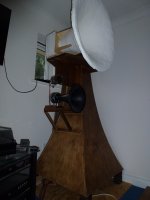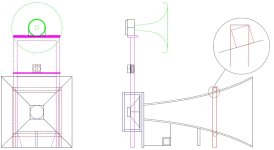Which one is the main horn and how will you change it?I'm considering changing the main horn from vertical
My comment about the Axi2050 being rumoured that it is not a good choice for a tweeter (up to 20kHz) was based on this review by Joseh Crowe and also the subjective impression from a friend who compared it to other drivers. He settled for Goto, poor guy. 🙂 It is really good to cross low, maybe down to 400Hz. Also, putting the upper crossover point low, like 2000Hz, should prevent cancellations together with a tweeter, according to GR research.[...]
If the people commenting on the Axi as tweeter aren't voicing the driver in a neutral way.....what weight does their opinion hold? DSP is going to be required to level out sensitivity. So if they mean the Axi isnt the best tweeter for passive eq, or no eq.... theres probably truth in that statement
https://josephcrowe.com/blogs/news/celestion-axi2050
"Conclusion
With the driver mounted on the ES290 Biradial and contour circuit in place to flatten the response, the Celestion Axi2050's behavior changed drastically at elevated listening levels. It went from pleasant and musical to somewhat strident in nature at the higher listening level. This is in the context of using the driver for midrange and treble duty.
It’s clear that the Axi2050 performs better on a large format midrange horn as a midrange only solution, as we see with the 1723 horn. Distortion is within my target for audiophile applications, although the response linearity was not matched compared to the BMS 4599HE, although it was still acceptable. "
Last edited:
There are many comments on the forum re Crowes axi test. I have Celestion axi2050s in SEOS 30 horns and like them a lot, although they are still only roughly dialed in (miniDSP flex eight). My previous setup was Altec 399-8As (alu. and paper diaphragms) in Altec 1505B horns (still have them, the 15cell multicells look cool 🙂 ).
Must say though that I probably dont hear anything past 14-15k, old ears 🙂
Must say though that I probably dont hear anything past 14-15k, old ears 🙂
Last edited:
My take on this is that it completely change the concept of the system. Anima concept allows good depth reduction with some compromise, quite hard to define if you maintain low cut and not that elevated position for the next horn (not as in your picture). By changing it orizontaly you loose all good packaging, not gaining much in your relatively small audition room. Also, today you have no excuse not using digital delays (and DSP) to compensate for so large acoustic path differences in such large horn system.Following some input from people with far more knowledge than I have on horns, I'm considering changing the main horn from vertical and would appreciate feedback [...]This potentially can allow me to simplify from 4 way to 3 way. I'll aim to use Celestion axi2050 c/w LeCleach horn and JBL 2405 as shown in the drawing.
View attachment 1166038
[...] Again, all comments welcome.
Thanks @Mr BA
I understand you are trying to get higher frequencies out of your larger horn. In addition this is going to change things quite a lot, but after some time you should find a way to make this work. The mouth conditions and effective length will change. Resonances due to axial reflections. Room modes coming from not so closely on the floor.
You'll also find the higher end of this will have a higher DI, it may be light on power. It may be challenging to cross to.
I understand you are trying to get higher frequencies out of your larger horn. In addition this is going to change things quite a lot, but after some time you should find a way to make this work. The mouth conditions and effective length will change. Resonances due to axial reflections. Room modes coming from not so closely on the floor.
You'll also find the higher end of this will have a higher DI, it may be light on power. It may be challenging to cross to.
This midbass horn is in one of my possible future plans. How does it sound up to 250Hz? Can you really meet the midrange at 250Hz? Did you ever measure the midbass horns response with a microphone? Which midbass driver is it?Current set up is 4 way, as shown below. Mid bass is currently vertical firing into the floor.View attachment 1166171
I'm proposing to rotate the mid bass from vertical to horizontal & go to either 2 way using Celestion axi2050 or 3 way using a i2050 ÷ jbl2450 as shown in the drawing View attachment 1166172View attachment 1166172
View attachment 1166171
Last edited:
As much as like Joseph he dropped the ball on his assessment of the Axi2050... He used to have a comments section on the bottom of the review....I called him out on several inconsistencies in his review....now the comment section is removed. I don't think theres any reason for me to respect his subjective opinion over my own. My experience in mixing and mastering gives me plenty confidence that my ears are fine to judge sound. Without getting wordy; There is something wrong with the match between the Horn and the Driver, its that simple. The FR on his horn is horrible, That should be the first red flag considered. The fact that the response changed drastically at elevated listening levels if red flag number....This is a SOA driver capable of playing 130db/1m without flenching.....Do you seriously believe that within domestic levels of "elevated listening levels" there would be an issue from the driver??? Thats asinine....My comment about the Axi2050 being rumoured that it is not a good choice for a tweeter (up to 20kHz) was based on this review by Joseh Crowe and also the subjective impression from a friend who compared it to other drivers. He settled for Goto, poor guy. 🙂 It is really good to cross low, maybe down to 400Hz. Also, putting the upper crossover point low, like 2000Hz, should prevent cancellations together with a tweeter, according to GR research.
https://josephcrowe.com/blogs/news/celestion-axi2050
"Conclusion
With the driver mounted on the ES290 Biradial and contour circuit in place to flatten the response, the Celestion Axi2050's behavior changed drastically at elevated listening levels. It went from pleasant and musical to somewhat strident in nature at the higher listening level. This is in the context of using the driver for midrange and treble duty.
It’s clear that the Axi2050 performs better on a large format midrange horn as a midrange only solution, as we see with the 1723 horn. Distortion is within my target for audiophile applications, although the response linearity was not matched compared to the BMS 4599HE, although it was still acceptable. "
This is the AXi2050 on my horn, with something like Filters to make it more level than the natural response.
This the highest thd reading on this measurement, 5% @ 8.76khz/112db/1m..... Do you understand how loud that is???
In the domestic setting, we will will never use that headroom....but I guess its good to know its there. Never too much headroom right?
So regarding Josephs comments. Lets be honest and realize that we can measure everything that we hear for the most part. Just show us with measurements how "drastically" the playback changed right?
Below the Axi2050 outperforms the other driver in almost every aspect... Yet he says that the driver on the right has better HF. Strange, and I don't believe him, as well I think something is off with the mating of the horn with the Axi. Even if that is true... his own measurements do not line up with his subjective stance. FR above 10hkz is smoother in first measurements??? IMD and THD is lower.... but theres some magical harshness that doesn't show in the measurements??? Then his subjective is that the other driver sounds better on the top? Doesn't make sense. I trust measurements not ears.
How did he improve the FR of the other driver in the last measurement btw? But not the Axi? Too much strange stuff going on...
Last edited:
OK I see now that on the last measurement of the Axi, its showing up to 50khz. So its safe to say the Axi is fine till 20khz according to his measurements. I was wondering how the response got so bad.
I gotta stop posting while in the car
I gotta stop posting while in the car
This is the AXi2050 on my horn, with something like 3 or 4 Filters to make it more level than the natural response.
Last edited:
Hi, I'm currently using a Fane Crescendo 15" driver on the vertical horn up to 250 Hz.This midbass horn is in one of my possible future plans. How does it sound up to 250Hz? Can you really meet the midrange at 250Hz? Did you ever measure the midbass horns response with a microphone? Which midbass driver is it?
It hands over to Audax PR170 on paper horn up to 1k2,
then Fostex D232 compression driver to 8kHz
JBL 2405 compression driver.
'm a novice at taking measurements, but here are three I've taken, which you may find the most useful.
These were taken with Behringer DCX2496 in operation and I used it to see the effect of different crossover slopes at the same point. I can't remember why I used Butterworth.
Behringer only has 3 outputs, so I've used a capacitor on JBL 2405
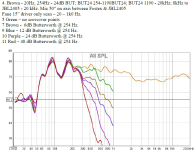
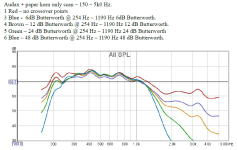
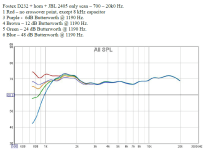
Re 250 Hz - A simple test that one of my friends did when he came round was to put the tuner onto BBC radio 3 and listen to male vocal - it was acceptable, not chesty, with nothing of note coming out of mid bass.
Thanks for your feedback.My take on this is that it completely change the concept of the system. Anima concept allows good depth reduction with some compromise, quite hard to define if you maintain low cut and not that elevated position for the next horn (not as in your picture). By changing it orizontaly you loose all good packaging, not gaining much in your relatively small audition room. Also, today you have no excuse not using digital delays (and DSP) to compensate for so large acoustic path differences in such large horn system.
The chance to buy a pair of secondhand Celestion axi2050 drivers came up, which had only been used domestically, so I bought them. The buyer gave me a pair of JMLC horns, but I won't be able to cross then @ 250 Hz, hence rotating bass horn through 90 degrees.
My plan is to convert one side and set them up active crossover. If it sounds better, change the second one.
Whilst the speakers will take up a bit more floor space, it's my music room, so my wife just closes the door. 😉
If it sounds worse, then I'll either swap it back or if I'm feeling brave make a larger horn to mate with axi2050 as part of a 3 way.
A passive crossover is an itch to scratch later.
Last edited:
Thanks for your insight. I'm on a learning curve so will be asking further questions as I go along.It may be challenging to cross to.
Sounds like a good/lucky purchase.The chance to buy a pair of secondhand Celestion axi2050 drivers came up, which had only been used domestically, so I bought them. The buyer gave me a pair of JMLC horns, but I won't be able to cross then @ 250 Hz, hence rotating bass horn through 90 degrees.
If you simply drop this newly acquired stuff into one channel of your current system, you'll have this -
[?]-250Hz via Fane Crescendo 15"
250Hz-1kHz via Audax PR170
1kHz-20kHz via Celestion axi2050
...and that should answer one of your earlier questions.
If you like the result, you'll know that you can simplify things by dropping the JBL 2405. No need to rely on reviews or hearsay about the Celestion axi2050 and how good it is as a tweeter, when you can simply try it for yourself 🙂
I still find the -13 dB suckout at 120 Hz somewhat disagreeable. Could be the sound wave bouncing right back into the horn and cancelling.
But I would not use a 15" above 250Hz even if it was pointing straight at me. Back to the drawing board?
But I would not use a 15" above 250Hz even if it was pointing straight at me. Back to the drawing board?
"I would not use a 15" above 250Hz even if it was pointing straight at me"
I would 🙂
I made a similar straight horn (smaller driver, bigger horn) and it measured fine 60Hz-1kHz. I used it as a dead simple 2-way (mono).
https://www.diyaudio.com/community/threads/artichoke-horn.298525/page-3
Lots of people (well a significant fraction of the people who are this nuts about audio) use similar midbass horns well past 250Hz.
The -13 dB suckout at 120 Hz could be anything. Most in-room measurements are this lumpy in the bottom octaves, horn / ported / sealed - doesn't matter.
The fix is usually to use multiple sources (to spread the lumps) and/or eq and/or room treatment.
I would 🙂
I made a similar straight horn (smaller driver, bigger horn) and it measured fine 60Hz-1kHz. I used it as a dead simple 2-way (mono).
https://www.diyaudio.com/community/threads/artichoke-horn.298525/page-3
Lots of people (well a significant fraction of the people who are this nuts about audio) use similar midbass horns well past 250Hz.
The -13 dB suckout at 120 Hz could be anything. Most in-room measurements are this lumpy in the bottom octaves, horn / ported / sealed - doesn't matter.
The fix is usually to use multiple sources (to spread the lumps) and/or eq and/or room treatment.
For PA it is fine, because you can't push 140dB from a compression driver near its lower limit. But in the livingroom I think we can do better than those 15" drivers with cones made of ikea boxes.
More than two of those midbass horns? Where is he supposed to sit? 😀
Maybe take measurements from different places around listening position. Things might not be as bad as it seems.
More than two of those midbass horns? Where is he supposed to sit? 😀
Maybe take measurements from different places around listening position. Things might not be as bad as it seems.
There is lots of crossover between good sound in PA and good sound at home. Good is good 🙂
"More than two of those midbass horns? Where is he supposed to sit?"
A horn purist could add more LF horns without sacrificing floor area simply by going vertical:
[Bass]
tweeter
mid
[Bass]
...but me, I'm no purist, and that's not how I'd do it. Multiple sources does not strictly mean multiple horns. Filling a 120Hz hole is pretty easy, and doesn't require a huge device. A relatively small direct radiator would suffice, especially if used nearfield.
In the right space, an IB array would also work, and these use no room space at all (if they vent into an attic, subfloor space, adjacent room, or outdoors). That's something I've done (and liked) before, as a horn alternative. A quad of IB drivers (for +6dB at LF) mouted in a room corner (for lots of boost at LF), gives horn-like efficiency without some of the drawbacks (taking up lots of floor space, sharp LF rolloff).
That is:
The "purist" freestanding midbasss horn I built occupies more than 2 square metres (8' by 4') and it only goes to 60Hz.
A horn approximation (quad in a manifold with maximised boundary loading) gets similar efficiency (+6dB for multiple drivers, +boost at LF), ocupies no room space and goes lower, with a less abrupt cutoff.
The IB manifold is something I've done before, I liked it, and I am doing it again in my current build: horns above ~350Hz, boundary loaded woofer array below, all soffit mounted so thay will take up exactly none of the listening space.
"More than two of those midbass horns? Where is he supposed to sit?"
A horn purist could add more LF horns without sacrificing floor area simply by going vertical:
[Bass]
tweeter
mid
[Bass]
...but me, I'm no purist, and that's not how I'd do it. Multiple sources does not strictly mean multiple horns. Filling a 120Hz hole is pretty easy, and doesn't require a huge device. A relatively small direct radiator would suffice, especially if used nearfield.
In the right space, an IB array would also work, and these use no room space at all (if they vent into an attic, subfloor space, adjacent room, or outdoors). That's something I've done (and liked) before, as a horn alternative. A quad of IB drivers (for +6dB at LF) mouted in a room corner (for lots of boost at LF), gives horn-like efficiency without some of the drawbacks (taking up lots of floor space, sharp LF rolloff).
That is:
The "purist" freestanding midbasss horn I built occupies more than 2 square metres (8' by 4') and it only goes to 60Hz.
A horn approximation (quad in a manifold with maximised boundary loading) gets similar efficiency (+6dB for multiple drivers, +boost at LF), ocupies no room space and goes lower, with a less abrupt cutoff.
The IB manifold is something I've done before, I liked it, and I am doing it again in my current build: horns above ~350Hz, boundary loaded woofer array below, all soffit mounted so thay will take up exactly none of the listening space.
- Home
- Loudspeakers
- Multi-Way
- A 4-way Horn speaker
